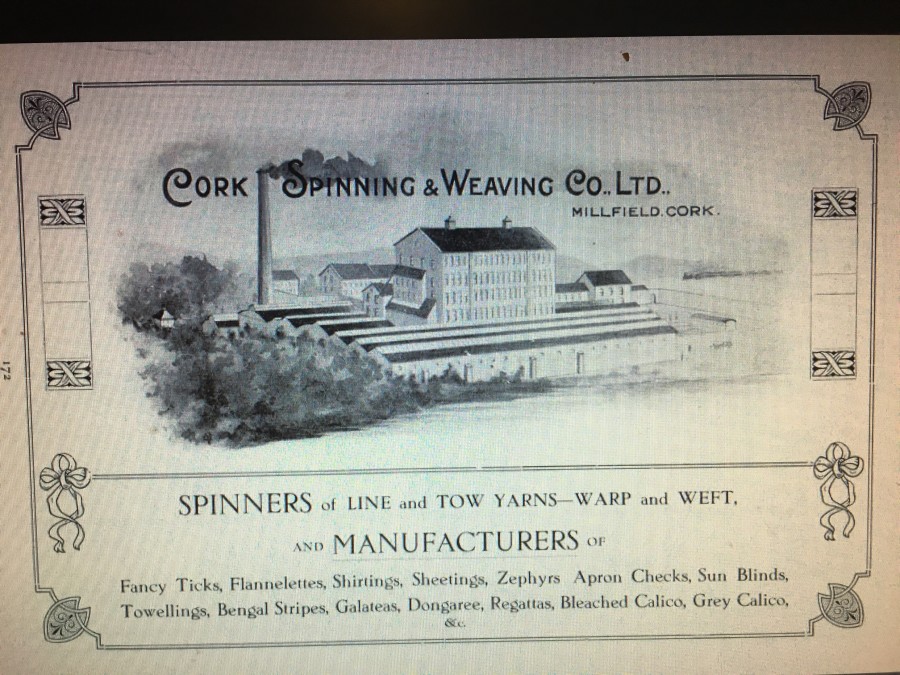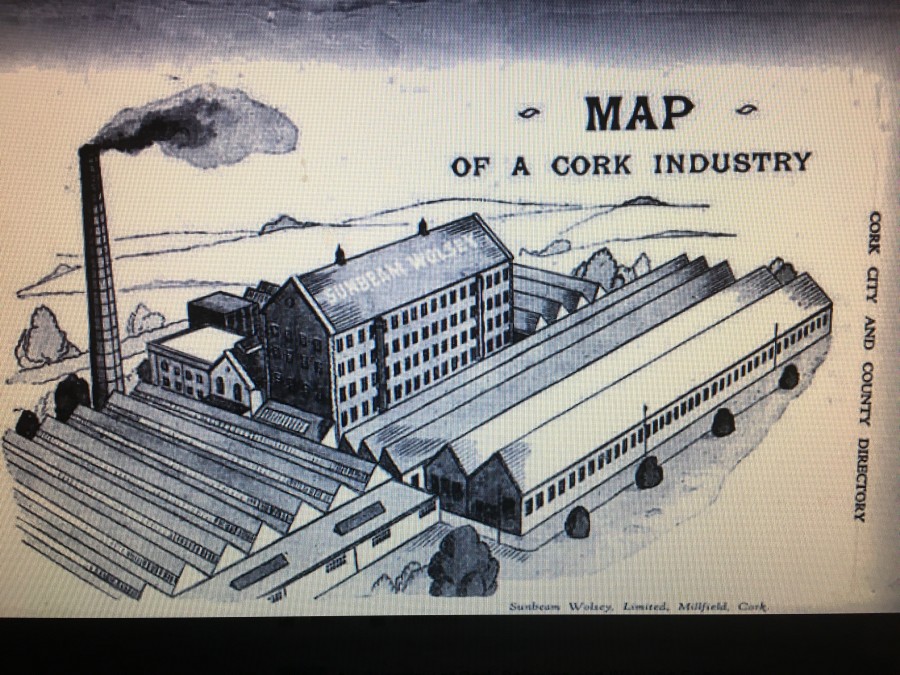Kieran’s Our City, Our Town Article,
Cork Independent, 31 August 2017
The Wheels of 1917: A Fire at Cork Spinning and Weaving Company
On Friday 24 August 1917, the premises of the Cork Spinning and Weaving Company at Millfield in Blackpool was the scene of an outbreak of a great fire. It resulted in the loss of large and valuable stocks of flax and other manufacturing materials. The fire was first discovered just before noon in the roughing and hackling departments of the spinning mill and by that time it had secured a solid grip on the buildings and spread rapidly. On the alarm being raised all the hands employed in the different departments escaped into the adjacent yard spaces. There, they were marshalled away at a safe distance from danger by the heads of the firm. The departments affected ran parallel and were divided by a stout wall over which the flames leaped sending the whole roof toppling in.
When the Cork Fire Brigade arrived, they found several male workers endeavouring to hinder the spread of the fire to the rear of the premises. Within an hour after the outbreak, the spread of the flames had been brought under control. All workers were instructed to return to work and provision made for diverting those hitherto employed in the destroyed departments to other branches of the business. About 1.40 pm, when it seemed that danger had been averted, it was found that sparks from the destroyed departments had ignited some of the material in a small adjoining storehouse at the rear, and what looked to be a devastating position was only overcome when the fire brigade intervened. Had the fire reached the main storehouse close by the major portion of the company’s stock might have been burnt out. The brigade worked under Deputy Superintendent Higgins and the City Engineer, Mr Delany, was present throughout.
The main building, a five storey brick building, was constructed between 1864 and 1866 and was the brainchild of William Shaw. Designed by Belfast architects, Boyd and Platt, it was the first industrial linen yarn-spinning mill outside of Ulster. The Millfield Mill was operated by the Cork Spinning and Weaving Company whose directors chose the site outside the city’s municipal boundary due to the fact, the company would not have to pay rates to Cork Corporation. One of its most famous directors was its acting chairman John Francis Maguire, a Westminster MP for Munster and also founder of the Cork Examiner. During construction, the Belfast designers of the mill made sure that fireproof jack-arched floors were present throughout the building and these were supported by cast iron columns supplied by the King Street Works in Cork. The mill began operating on 15 February 1866 operating with 900 spindles and the following year, the company was employing seventy Belfast linen workers along with 630 local women, girls and boys.
By the beginning of the twentieth century, the mill was one of the most important flax spinning mills outside of Ulster. As a symbol of local enterprise, the mill was also operating looms for weaving and by 1920 was employing upwards on 1,000 people. The 27th annual report of the Cork Spinning and Weaving Company (available in Cork City and County Archives) reveal that the trading conditions in 1916 were under great difficulties due to scarcity of raw materials. However, the government had secured supplies of Russian flax to keep the mills going. Prices were described at being at a dangerously high level. By 1917 supplies from Russia had been stopped. Irish flax was controlled by Government and spinners were required to spin yarns suitable. A year later, there had been an increase in working capital required owing to enormous increase in price of materials and costs of production.
By January 1921, between 600 and 700 hands were made temporarily unemployed as a result of the closing of the flax mills of the Company. This action was rendered necessary by the fact that the company had sold very little of their stock within the previous few months, and indeed the whole trade was practically at a standstill.
The year 1924 marked the closure of the Cork Butter market adjacent Shandon and the opening of a knitwear factory on the site by William Dwyer. In the 1930s, Dwyer transferred his factory from Shandon to the Millfield textile factory Blackpool in order to expand his business. Three decades later, the Dwyer factory in the 1960s, the factory was witnessing much success and employed 1,100 people. It also attracted other smaller firms to the complex and was one of the city’s largest employers. The House of Dwyer also operated the Lee Hosiery Factory, Lee Shirt Factory and Lee Clothing Factory.
On 8 October 1945, the solemn blessing of Cork’s new Church, the Church of the Annunciation of the Blessed Virgin took place. It was a gift of William Dwyer to the North Cathedral Parish.
In the mid-1970s, the Millfield Factory was sold to UK firm, Courtaulds. Subsequently, in the 1980s, the factory employed over 3.500 people and in the early 1990s was taken over by Sunbeam Industries Limited, based in Westport. In 1995, Sunbeam Knitwear closed and the site became home to many local enterprises. The old nineteenth century block was devastated by fire on 25 September 2003.
Kieran’s new book, Secret Cork, is now in Cork bookshops.
Captions:
910a. Advertisement for Cork Spinning and Weaving Company, 1917 (source: Cork City Library)
910b. Plan of Cork Spinning and Weaving Company from Guy’s City and County Directory of Cork (source: Cork City Library)

